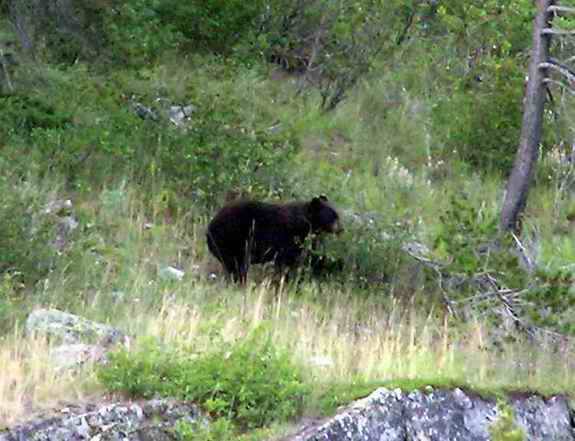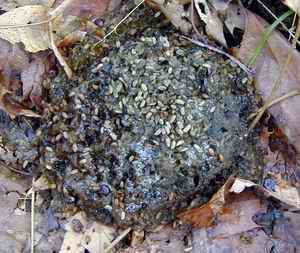|
Return to Hiker's Notebook Home Page
Common Name: Black Bear, American bear, Cinnamon bear, Glacier bear, Kermode bear - Alternative common names based on minor differences in appearance and DNA among the 16 recognized subspecies of the Ursus americanus. Scientific Name: Ursus americanus - From the Latin word ursus meaning bear and a Latinized word for American; literally American bear.
The Black or American bear is found only in North America, with a population estimated at approximately 750,000 ranging from Florida and northern Mexico to the northern reaches of Alaska and Canada. They are called black bears because they generally dark but can range from light brown (Cinnamon bear) to white (Kermode bear of coastal British Columbia).
Black bears have excellent senses. They see colors and have good visual acuity for near-field objects. They hear a broader frequency range than humans with a greater sensitivity. Their olfactory area is 100 times that of humans; their sense of smell is exceptional. A group of bears is called a sloth from the Old English word slowthe which means slow, a term rarely used since they appear ponderous but in actuality they can run 30 miles per hour. They can swim more that a mile in fresh water. Black bears are normally silent; they make blowing noises and clack their teeth when they are agitated. The bear growl heard in movies is generally created by slowing down the growl of a wolf in order to provide the desired ferocious effect. Black bears are docile and attacks on humans are very rare. The timorous disposition of black bears is attributed to their evolution over a million years of their coexistence with more powerful predators, necessitating passivity and arboreal escape routes. One of the greatest misconceptions is that black bears will attack if their cubs are threatened. This is a trait of grizzly bears; about three-quarters of all fatal grizzly bear attacks are from mothers defending cubs. There have only been 43 recorded fatal black bear attacks in North America, none of which involved the defense of a cub. The fatal attacks that have occurred were primarily unprovoked, predatory assaults in remote areas in which the victim was eaten. There is no consistent explanation why about one out of every half a million black bears becomes a human predator.
The mating season for black bears generally occurs in the early summer months, the males rubbing against trees to leave their scent for any interested female. Females also leave scent markings, though less frequently and later in the summer, perhaps to indicate a lack of fulfillment. Female bears have some degree of control over the fertilization process. They are induced ovulators; the eggs are not released from the ovaries until after mating has occurred. Implantation of the fertilized eggs in the uterus is does not occur until early winter, a practice known as delayed implantation.
Delayed implantation prolongs the period of time between mating and parturition and results in a longer gestation period. It is practiced by a small group of carnivores, including bears, badgers, weasels, otters and wolverines. It is not altogether clear to scientists what utility delayed implantation imparts to a species. One theory is that the mating time is set to coincide with the animals' maximum nutritional health at the height of food availability. Delayed implantation is necessarily employed to extend the gestation period so that birth does not occur at the beginning of winter, as this would not be conducive to survival of the offspring. The converse theory is that the time of parturition is fixed by the need for offspring to survive the winter. A fixed gestation period would then require mating in the middle of the winter, when low nutrient levels would restrict the virility of the males and the fecundity of the females. Delayed implantation then advances the mating period to more opportune conditions.
Female black bears give birth to two or three cubs biennially in January. They weigh about one pound at birth and spend the next three months nursing, emerging from the winter den in the spring weighing about six pounds. The cubs remain with the mother for about seventeen months when they are forced away about one week before the next mating cycle. The male bears are solitary except for mating and take no part in the raising of the cubs. The ratio of females to males is one-to-one at birth. However, as the males are killed much more frequently by hunters than the females, the sex ratio of adult bears can be as high as four-to-one. Almost all adult bears die from human-related activities, primarily hunting. The average age at death of hunted bear populations is 4 years.
Bears are omnivores with a high preference for insects, nuts, fruits and selected vegetation, oftentimes traveling more than fifty miles from their home range while foraging. They will eat meat and other vegetation but only when there is a scarcity of their preferred foods. Black bears dig up hornets' nests to retrieve the brood comb that contains the larvae, suffering the persistent stings mitigated only by the thick fur of their incipient winter coats. Their taste for insects extends to ants; they dig up colonies in spite of the ants' defensive formic acid onslaught to consume vast quantities of pupae and larvae, which have a higher fat content than the adult ants. Black bears will eat the meat left on a deer carcass that has been winter-killed and neglected by hunters, sometimes dragging it to denser cover to shield it from other predators. They will also eat fledglings and eggs, shying away from the feathers of older fowl. Black bears climb trees to eat nuts, primarily acorns and beech nuts, frequently making platforms that look like nests for stability while pulling down branches to facilitate the harvest. It is literally the fruition of the fall that provides the black bear with the calories needed to add weight for the winter famine. Blackberries, blueberries, raspberries and the various cherries are all sought with consummate thoroughness, to the extent that small trees are bent to the ground to reach all of the fruit. Bear scat is testimony to the ingredients of the diet of the black bear, as fruit seeds are pervasive. Commonly found on trails, particularly during the autumnal feasting period, bear scat generally has a rather pleasant smell; it contains no parasites that are harmful to humans as is the case with the droppings of most other carnivores.
Black bear hibernation ranges from as long as 7 months in the north to very little or no hibernation in the south, where food is relatively plentiful throughout the year. Hibernation is a means to slow down the metabolic rate so as to save energy stored up in the summer. An anomalous behavior that counters this conservation strategy is that black bears expend considerable energy in the preparation of a different den every year. Choosing a likely looking burrow, cave, rock crevice, hollow tree or even a slight depression on the ground, they prepare the nest by laying down a layer of insulation consisting of stripped bark, leaves and club moss. How bears remain healthy through a long hibernation may have important medicinal implications. During hibernation, black bears produce a bile fluid called tauro ursodeoxycholic acid (UCDA) that prevents gallstones which could develop from the unusually high levels of cholesterol sustained during the long sedentary winter. Their retained urine does not poison them, but rather is broken down to produce nitrogen for the creation of proteins that serve to maintain their muscle mass.
Bears have been important in traditional Chinese medicine for millennia. The bile from the gall bladder, with its attendant UCDA, has been used in the treatment of cancers, burns, asthma and liver damage, particularly that associated with the over-consumption of alcohol. China has bear bile farms where about 10,000 bears are sequestered with surgically implanted devices to facilitate bile removal. Each bear produces enough bile in its five year life to account for 220 gall bladders from wild bears. UCDA made synthetically from the bile of cows is used in Western medicine to dissolve gallstones. |

